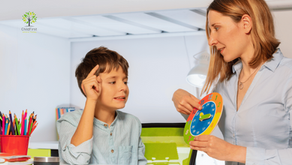Top 10 Books to Read on Autism for Understanding Your Child
- ChildFirst Behavior Therapy

- Apr 21, 2024
- 5 min read

Understanding autism spectrum disorder (ASD) is crucial for parents and caregivers to provide effective support and nurture the potential of their children. With a myriad of resources available, selecting the right books becomes essential. Here's a curated list of the top 10 books that offer valuable insights into understanding autism, aiding parents in navigating the unique challenges and celebrating the strengths of their child. Additionally, seeking guidance from experts at an ABA Therapy Near You can provide personalized support and strategies for individuals with ASD and their families.
"The Reason I Jump" by Naoki Higashida:
Written by a thirteen-year-old boy with autism, "The Reason I Jump" provides a profound and illuminating glimpse into the mind of someone with ASD. Through a series of questions and answers, Naoki offers valuable perspectives on communication, receptive experiences, and the inner workings of his world.
"Neurotribes: The Legacy of Autism and the Future of Neurodiversity" by Steve Silberman:
"Neurotribes" is a meticulously researched exploration of the history, science, and cultural impact of autism. Silberman delves into the evolution of autism diagnosis, challenges prevailing misconceptions, and advocates for embracing neurodiversity to create a more inclusive society.
"Uniquely Human: A Different Way of Seeing Autism" by Barry M. Prizant:
In "Uniquely Human," Prizant offers a compassionate and empowering perspective on autism, emphasizing the importance of understanding and accepting individuals on the spectrum for who they are. Through insightful anecdotes and practical advice, he highlights the significance of focusing on strengths and fostering meaningful connections.
"The Autistic Brain: Thinking Across the Spectrum" by Temple Grandin and Richard Panek:
Temple Grandin, a renowned autism advocate and author, collaborates with science writer Richard Panek to explore the complexities of the autistic brain. Drawing on personal experiences and scientific research, they provide valuable insights into cognitive patterns, and the diverse ways individuals with autism perceive the world.
"Ten Things Every Child with Autism Wishes You Knew" by Ellen Notbohm:
In this insightful book, Notbohm presents essential insights into the perspective of children with autism, offering practical advice for parents, educators, and caregivers. By highlighting ten key concepts, such as communication challenges, she fosters empathy and understanding while guiding readers in supporting children with ASD effectively.
"Autism Breakthrough: The Groundbreaking Method That Has Helped Families All Over the World" by Raun K. Kaufman:
"Autism Breakthrough" introduces the Son-Rise Program, a revolutionary approach to autism treatment developed by Raun Kaufman, who overcame his severe autism diagnosis. Through personal anecdotes and practical strategies, Kaufman empowers parents to create personalized interventions focused on connection, acceptance, and growth.
"Look Me in the Eye: My Life with Asperger's" by John Elder Robison:

In this candid memoir, John Elder Robison shares his journey of growing up with undiagnosed Asperger's syndrome and navigating the complexities of social interaction. With honesty and humor, he offers valuable insights into the ASD experience, challenging stereotypes and promoting greater understanding and acceptance.
"Thinking in Pictures: My Life with Autism" by Temple Grandin:
Temple Grandin's memoir, "Thinking in Pictures," offers a unique glimpse into her life as a highly successful individual with autism. Through vivid descriptions of her receptive experiences and thought processes, she sheds light on the strengths and challenges associated with autism, inspiring readers to embrace neurodiversity.
"The Out-of-Sync Child: Recognizing and Coping with sensory Processing Disorder" by Carol Kranowitz:
While not exclusively focused on autism, "The Out-of-Sync Child" is an invaluable resource for parents seeking to understand and support children with receptive processing challenges often associated with ASD. Kranowitz provides practical strategies for identifying receptive issues and implementing receptive-friendly interventions to promote comfort and well-being.
"Engaging Autism: Using the Floortime Approach to Help Children Relate, Communicate, and Think" by Stanley I. Greenspan and Serena Wieder:
"Engaging Autism" introduces the Developmental, Individual-differences, Relationship-based (DIR/Floortime) model, a comprehensive approach to promoting social-emotional development in children with autism. Through case studies and practical guidance, Greenspan and Wieder empower parents to foster meaningful connections and facilitate their child's growth and development.
Conclusion:
Navigating the complexities of autism spectrum disorder can be challenging for parents, but with the right resources and support, they can better understand and nurture the potential of their child. The books listed above offer valuable insights, practical advice, and inspiring stories that can empower parents to embrace neurodiversity, foster meaningful connections, and celebrate the unique strengths of their children with autism. For further assistance and support in understanding and addressing your child's needs, consider reaching out to ChildFirst Behavior Therapy. We offer Center-based ABA Therapy Services in Arlington Heights, II bringing hope and wellness to your kids with autism.
FAQs
What makes "The Reason I Jump" by Naoki Higashida a valuable read for parents of children with ASD?
This book offers a rare insight into the mind of a person with autism, providing firsthand perspectives on communication, receptive experiences, and inner thoughts, helping parents better understand their child's world.

Why is "Neurotribes: The Legacy of Autism and the Future of Neurodiversity" by Steve Silberman recommended for parents seeking to understand autism?
"Neurotribes" delves deep into the history, science, and cultural impact of autism, challenging misconceptions and advocating for embracing neurodiversity, making it an essential read for gaining a comprehensive understanding of autism spectrum disorder (ASD).
What sets "Uniquely Human: A Different Way of Seeing Autism" by Barry M. Prizant apart from other books on autism?
Barry M. Prizant's book offers a compassionate and empowering perspective on autism, focusing on understanding and accepting individuals on the spectrum for who they are, while providing practical advice for parents and caregivers.
How does "The Autistic Brain: Thinking Across the Spectrum" by Temple Grandin and Richard Panek contribute to understanding autism?
Temple Grandin and Richard Panek explore the complexities of the autistic brain, drawing on personal experiences and scientific research to provide valuable insights into cognitive patterns, and unique perceptions.
What makes "Ten Things Every Child with Autism Wishes You Knew" by Ellen Notbohm a must-read for parents and educators?
Ellen Notbohm's book offers essential insights into the perspective of children with autism, presenting practical advice and fostering empathy by highlighting ten key concepts such as communication challenges.
Why is "Autism Breakthrough" by Raun K. Kaufman recommended for parents seeking effective interventions for their child with ASD?
Raun K. Kaufman introduces the Son-Rise Program, a groundbreaking approach to autism treatment, empowering parents with personalized strategies focused on connection, acceptance, and growth.
What makes "Look Me in the Eye: My Life with Asperger's" by John Elder Robison a compelling read for understanding autism?
John Elder Robison's candid memoir offers valuable insights into the ASD experience, challenging stereotypes and promoting greater understanding and acceptance through personal anecdotes and humor.
How does "Thinking in Pictures: My Life with Autism" by Temple Grandin contribute to understanding the strengths and challenges of autism?
Temple Grandin's memoir provides a unique perspective on autism, offering vivid descriptions of receptive experiences and thought processes, inspiring readers to embrace neurodiversity.
Why is "The Out-of-Sync Child" by Carol Kranowitz included in this list of top books on autism?
While not exclusively focused on autism, Carol Kranowitz's book offers valuable insights and practical strategies for parents dealing with receptive processing challenges often associated with ASD, aiding in better understanding and supporting their child.
What makes "Engaging Autism" by Stanley I. Greenspan and Serena Wieder a recommended read for parents of children with ASD?
"Engaging Autism" introduces a comprehensive approach to promoting social-emotional development in children with autism, empowering parents with practical guidance and case studies to facilitate their child's growth and communication skills










Comments